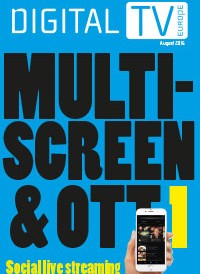
After more than 40 years of operation, DTVE is closing its doors and our website will no longer be updated daily. Thank you for all of your support.
The OTT hotlist
As the over-the-top video market continues to come of age, Digital TV Europe shines a light on some of the most interesting services to have emerged in recent times. Andy McDonald reports.
 The over-the-top video market continues to grow as content providers big and small look to establish direct, cross-device and contract-free relationships with their viewers. While the examples in this article will offer a flavour of the new types of services that are coming through, there are a number of factors at play in what is becoming an increasingly crowded OTT market.
The over-the-top video market continues to grow as content providers big and small look to establish direct, cross-device and contract-free relationships with their viewers. While the examples in this article will offer a flavour of the new types of services that are coming through, there are a number of factors at play in what is becoming an increasingly crowded OTT market.
One major theme that can be seen in the European OTT market today is that of consolidation among broadcasters, which are opting to work together to more effectively compete against larger global players like Netflix and Amazon.
In the UK there has been much talk of a ‘Kangaroo 2’-style joint platform among the public service broadcasters, with the name referencing an earlier project that was blocked on anti-competitive grounds back in 2008. In France, commercial broadcasters TF1 and M6 Group and public broadcaster France Télévisions recently teamed up to launch a joint national OTT TV platform called Salto. Meanwhile in Germany ProSiebenSat.1 and Discovery plan to launch a new streaming service next year that will incorporate ProSiebenSat.1’s 7TV and Maxdome services, Eurosport Player and a range of other content.
“Local broadcasters banding together in their national markets potentially makes a lot of sense,” says Ampere Analysis research director Ed Border, pointing to the broader catalogue and simplified consumer experience that comes along with this. “Consumers can sign up once, and pay once, as opposed to taking three or four separate, fragmented services. Meanwhile, a lot of the tech-based costs of hosting and running an SVOD service are pooled, reducing the expenses per individual partner.”
However, Ampere analyst Lottie Towler points out that there are still hurdles to overcome – even though competition concerns are dying down in the wake of the “intense market disruption” caused by the big international SVOD providers. “Loss of control of content promotion, service strategy and marketing could be a difficult adjustment for some players and depending on the market it could prove challenging for public service broadcasters to transition to a subscription-based model,” she says.
Technology, media and telecoms analyst Paolo Pescatore says that regional broadcasters coming together is “long overdue” and is arguably now not enough to compete with the global giants: “Too little, too late!” He claims that broadcasters should instead focus on their core offering – which is simply their content. “As FAANG [Facebook, Amazon, Apple, Netflix and Google] spend more on local programming, then there is no reason why they shouldn’t partner with each other – a great match for both broadcasters and FAANG,” reasons Pescatore. “Also, I firmly believe that local players should work more closely with telcos who have a direct relationship with their subscribers. This way, they can unlock opportunities to provide users with more immersive experiences and identify new sources of revenue.”
While the global SVOD giants’ consolidation of power is certainly one a key theme of the OTT market in 2018, another is the rise of the niche OTT services, which can carve out a business by offering a focused and often highly curated catalogue aimed at a smaller subset of consumers around specialist interests – including sports.
“Niche services with particular angle on content proposition stand better chance to cohabit with big services like Netflix and Amazon,” says IHS Markit’s manager of research and analysis for broadband media, Irina Kornilova. “Crunchyroll – anime, WWE Network – wrestling, Eros Now – Bollywood – are some of the examples of companies using their niche proposition to attract ‘super-fans’.”
However, she says, is it is harder for small generalist services to compete in the market.
Border at Ampere claims that “a degree of consolidation within the SVOD market is inevitable after a tumultuous few years,” and says there have been several examples recently of even some larger players closing down operations – for example, Canal Plus Group recently announced the decision to shut down its SVOD service CanalPlay, with competition and regulation key factors.
Earlier this year, T-Mobile Netherlands announced plans to shut down its mobile-first over-the-top TV service Knippr and in France local reports suggest OTT TV service Molotov is also looking for a buyer, indicating that the business model for re-streaming TV channels over-the-top is also challenging in some markets.
Here, then is DTVE’s ‘hotlist’ of five OTT services to watch.
Sky España
The launch of Sky España in September 2017 marked a significant milestone for the European pay television giant, as it was the first time it had launched a pureplay over-the-top offering in a market where it did not already have a pay TV presence.
For €10 per-month, Sky customers in Spain can sign-up on a contract-free basis to receive 16 top Spanish pay TV channels – including Fox, AXN, TNT, MTV, Disney Junior, Nickelodeon and La Liga 1|2|3 TV. On top of this, subscribers can access 3,600 hours of on-demand films and series, including Sky Original productions that are exclusive to the service in Spain like Gomorra, Save Me, The Last Panthers and forthcoming titles like Patrick Melrose and A Discovery of Witches.
“Sky presents a wide offer perfect for families with the most appealing series, kids content, movies and football, which is the perfect choose for the over 11 million households in Spain that still don’t have any kind of pay TV services,” explains David Nunez, director of Sky Spain. “We have replicated the success of the Now TV model and technology, but [are] using the Sky brand to take advantage of the brand awareness in the market,” he adds, citing the OTT service that Sky runs in the UK, Ireland and Italy. In Germany its equivalent product is branded Sky Ticket. “There is a big demand for a service like ours.”
Nunez says that Sky’s move into Spain was part of a strategy it had worked on and studied for a while before launch, and that Sky has seen “positive growth” in the market since it went live. While Spain is a hotly contested OTT market with rivalry from the likes of Netflix, Amazon and HBO, he believes that Sky’s combination of live and on-demand content from popular pay TV channels, along with series, films and kids content, differentiates its offering.
“From our point of view, the OTT market still has room for expansion,” says Nunez discussing how he sees the OTT market developing in a broader sense in the coming years. “It offers a great freedom for the user to access content and nowadays content is king. Sky is the largest European investor in TV content with an annual spending on programming of E8 billion, which allows us to have the most appealing shows and films for our users.”
Filmstruck
Filmstruck is a joint venture subscription film service between Turner’s Digital Ventures & Innovation (DV&I) group and Warner Bros Digital Networks, which launched in Europe earlier this year after the brand debuted in the US in 2016.
The curated movie service is targeted at film lovers, offering up a regularly refreshed selection of classic, cult, independent, art house, documentary and world film titles. Filmstruck draws on the Warner Bros library, the Criterion Collection and content from local partners. It rolled out in the UK in February and then in France and Spain in mid-June.
The European launch came after months of development and Filmstruck partnered with Accenture video services from a technology standpoint. Turner claims that the service is designed to meet a consumer need that is not being fully served – to bridge a gap in the market between the more generalist TV fare provided by the likes of Netflix, Amazon, Canal Play or Movistar+ with the artsier content found on more direct film service rivals like Mubi, France’s La CineTek and Spain’s FilmIn and FlixOlé.
“Rolling FilmStruck out is a significant next step for us at Turner,” said Aksel van der Wal, executive vice-president, DV&I, Turner International. “We’ve chosen markets with a rich heritage in and love for movies, which are also rapidly developing SVOD markets, which makes them exciting markets to tap into with what we believe is a fresh and differentiated offering working with fantastic content partners. Launching these kind of new services alongside Turner’s core business offering is part of the fan-centric strategy we’ve adopted to engage our audiences.”
NextUp
NextUp focuses on full-length stand-up comedy specials and was founded in 2016 by the team behind the YouTube channel and live night ComComedy and the fee-free crowdfunding platform FringeFunder. The UK service – which counts the former president of AMC Global and Sundance Channel Global, Bruce Tuchman, as an investor – currently features more than 90 comedy specials. A new episode is released each week and household names like Ed Byrne and Richard Herring are presented alongside new and up-and-coming talent.
“Much of the content is produced in-house and our members are able to come to live recordings and suggest acts for showcasing on the service,” explains founder Sarah Henley. “NextUp is targeted at stand-up comedy fans who are digitally engaged and looking for more breadth and depth in terms of a catalogue than the mainstream providers are able to offer – our members love comedy and are keen to discover great new shows.”
According to Henley, the service supports acts that represent the “breadth and diversity” of the comedy circuit and aims to give comedy shows a life beyond their initial live performances. “We noticed how many incredible shows simply died a death after the Edinburgh festival or a tour, particularly with the bottom falling out of the DVD market,” she says. “Fans who couldn’t make the show live never got to see it, and comedians had no visual record of their work and no way to monetise the content when it wasn’t being performed live.”
NextUp aims to get comedy content in front of as many fans as possible and to create an additional revenue stream for comedians. As a specialist SVOD service it also aims to provide more breadth and depth in terms of a catalogue than other more mainstream on-demand service providers, with most of the content in its catalogue exclusive to the NextUp platform.
“We see ourselves more as a bolt-on to a Netflix or Amazon Prime subscription,” says Henley. “While I’m sure our subscribers enjoy watching the big players on Netflix, there are loads more great shows to discover on NextUp that Netflix and Amazon simply wouldn’t take the risk on. The great thing about being a specialist service is we are lean and can move quickly – if an artist wants their show to feature on NextUp, we can film it that month and launch within two weeks while the content is still fresh.”
NextUp partners with Simplestream for video delivery and is available via the web and as apps for Apple TV, iOS, Android, Amazon Fire with Roku due to launch soon. The service is also aggregated by Amazon Channels.
ESPN+
Launched with much fanfare in April of this year, ESPN+ is Disney’s first major entry into the premium over-the-top sports market. It is also the first taste of its broader SVOD ambitions, with a separate Disney-branded offering that will feature Disney, Pixar, Marvel and Lucasfilm movies due in late 2019 – a move that will see Disney pull all its movies from Netflix when its current deal with the SVOD giant expires at the end of next year.
ESPN+ is available in the US and includes live MLB baseball, NHL ice hockey, MLS soccer, alongside a range of college sports, PGA Tour golf, Grand Slam tennis, boxing and international rugby and cricket. It launched as part of a revamp of the ESPN App, creating an all-in-one digital sports platform with easy access to all of ESPN’s news, scores, analysis, video and audio content.
The service is the first direct-to-consumer service from Disney Direct-to-Consumer and International – the multiplatform media, technology and distribution organisation created by Disney’s Media Networks and Studio Entertainment groups. ESPN+ is powered by Disney’s majority-owned video streaming technology company BAMTech, in which it upped its stake from 33% to 75% through a US$1.58 billion deal agreed in August 2017.
“The launch of ESPN+ marks a new era of innovation for The Walt Disney Company, defined by a direct and personal relationship with our consumers,” said Kevin Mayer, chairman, direct-to-consumer and international, The Walt Disney Company, marking the service’s release in April. “This product reflects our new direct-to-consumer strategy focused on combining our incomparable brands and unmatched content with industry-leading technology to give users an unparalleled digital experience.”
ComBo
ComBo is Swedish operator Com Hem’s latest streaming service, which head of TV product Jessica Andersson describes as a “natural step forward” in the company’s product offering. The over-the-top service includes some of Com Hem’s best films and series and is designed as an add-on product for TV and broadband customers. “It’s a complement to our linear channel packages which gives customers access to thousands of series, movies and documentaries, wherever they want and at a competitive price.”
Soft-launched in the second quarter of this year, ComBo offers content from the likes of Fox, National Geographic, Viacom and Viasat and is distributed through its existing play product, Com Hem Play, which has been around for several years. “We see an increasing demand for flexible VOD-products and our current agreement with content providers enables us to launch a selection of premium content for a reasonable price,” Anderson says of the SEK49 (€4.75) per-month offering.
The reason ComBo signals a logical way forward for Com Hem is that is essentially a standalone, ‘box-less’ SVOD offering – albeit one that was developed alongside the company’s recently launched TV Hub, a lightweight Android-based TV device that is now its main TV-offering alongside TiVo.
Discussing the service at its launch in April, Com Hem Group CEO Anders Nilsson said that ComBo opens up a new segment in the market for Com Hem and could be a significant growth driver over time: “We do not expect this to materially affect our near-term growth but it will allow us to tweak the functionality, content and sales channels to eventually develop ComBo into a standalone off-network TV service, catering to a much larger potential customer base.”
For Andersson, Com Hem is taking on an aggregator role, partnering with rather than trying to compete against large OTT players like Netflix and Viaplay. She predicts that as the OTT market develops further in the coming years there will be more viewing of this type of content and more services launching. “At the same time complexity increases for customers, where it’s getting harder to access all content through one provider and service,” she says. “This is an area where we believe there still is an opportunity for development.”
In Focus: What makes a successful OTT launch
To get a view on how the OTT market is shaping up, DTVE asked some of the space’s leading vendors to discuss over-the-top strategies and best practises. Brightcove’s senior vice-president of international, Mark Blair, says that while client challenges differ, there are common themes such as: how to best reach new audiences and attract new revenue streams using pre-existing content; and how to deliver big live moments, like sports events, at scale and in a cost-efficient way.
“Great content and user experience must be at the heart of a service,” says Blair. That applies to anything from “curation of the best world cinema or channel dedicated to making the best home-brewed beer.” He claims that in 2018 viewers expect to be served high-quality video content, without buffering, across devices. With an SVOD model, subscription payments must be simple. With AVOD, ads must be unobtrusive.
“To make sure your service makes the cut, be different,” says Blair. “Know your audience inside out, create and curate what will move them to come back. Also, don’t worry about committing to high costs in order to launch – we work with a range of brands who have different cash flows.”
At Kaltura, co-founder and president and general manager of Kaltura’s media and telecom business, Shay David, agrees that the consumer experience is key to a successful OTT service. “Users don’t care about network quality, device management, security and DRM, billing etc. What they care about is having a great viewing experience on any device at any time.”
David says that best practises for Kaltura’s customers include “making sure the TV platform is in the background and the consumer experience is in the foreground”. He also stresses the importance of Kaltura’s ‘targeted TV’ solution that uses big data, machine learning and AI to create a personalised TV experience for each viewer.
Asked how he sees the market shaping up in coming years, David says: “We see massive consolidation coming on both the provider side and the vendor side. As in many other mature markets, big players will win the day. This is a good thing: consumers need choice, but they don’t need the hassle of subscribing to 20 different services, they need some aggregation.”
As for smaller players, hoping to compete, he recommends that they band together – either with the help of larger independent tech providers or existing operators. “In this market there is strength in numbers.”
Ostmodern’s CEO Tom Williams says that there are tough challenges facing broadcasters and content owners today – not least because there is so much choice and competition for viewers’ time. He believes that a successful OTT service requires content providers to identify the value proposition between the content, the technology and the audience. “It demands creating a service that is unique and does not aim to copy others’ practices.”
“Young people in particular are turning away from linear TV,” he says. “The competition is not just found in Netflix and Amazon but in other digital interests such as gaming and social media. Simply launching an OTT service is not enough in itself.”
Williams claims that the size of catalogue is not always a barometer to success as “too much choice can overwhelm a user” and abundance of poor-quality content “holds little value”. Factors that do inform success, he suggests, are launching a new or updated service with a “coherent feature set” that addresses what audiences need, built in line with market changes, new behaviours, business demands and growing content. Considered UI design and careful editorial efforts by service owners are also key.




